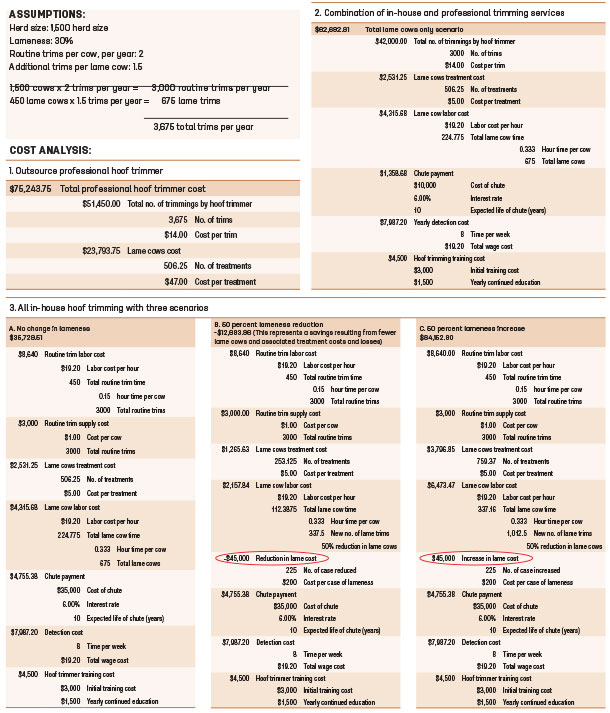First, as tempting as it is to cut expenses these days, one place that never pays off in the long run is cutting back on the amount of trimming being done. The best way to get a better return on trimming is by preventing new lameness. When every lame case costs approximately $500, it is even more crucial given this downturned economy to stay on top of regular maintenance trimming. Regardless of who is doing the trimming, a routine schedule should not be compromised.
So how do you decide if there is a higher annual return on investment (ROI) with contracting out hoof trimming to a professional or taking the important chore in-house? Let’s take a look at a scenario for a 1,500-cow dairy with a 30 percent lameness incidence (industry average). Four options are demonstrated in the cost analysis chart:
Click here or on the image above to view it at full size in a new window.
1. Outsource to professional trimmer: Contract exclusively with a professional trimmer for all hoof work. A good trimmer will always pay for themselves and have a good ROI.
Total cost = $75,244
2. Combination: A combination of both outsourcing and insourcing, by which a professional trimmer performs regularly scheduled trims, including dry-off and mid-lactation, while the trained employee takes care of weekly lameness detection and lame cow treatments. This accounts for the investment in a basic-level on-farm trimming chute and employee training.
Total cost (including labor, equipment and training) = $62,693
3. In-house: Rely solely on in-house trimming, where a trained farm employee performs all the dairy’s necessary trimming as well as weekly lameness detection. This accounts for the investment in a professional-level on-farm trimming chute and extensive employee training.
a. All in-house with no change in lameness:
Total cost (including labor, equipment and training, and assuming no change in lameness level among the herd)= $35,230
b. All in-house with 50 percent reduction in lameness:
Total cost (including labor, equipment and training) = -$12,694* (*This represents a savings resulting from fewer lame cows and associated treatment costs and losses.)
c. All in-house with 50 percent increase in lameness:
Total cost (including labor, equipment and training) = $84,151
As demonstrated by these scenarios, dairy farmers have options to consider when it comes to completing the important tasks of lameness detection, treatment and regular trimming. To make the best choice for your operation, think about how these examples could play out. In the best-case scenario, establishing a five-star in-house trimming program could not only save costs but also heighten lameness prevention.
On the contrary, however, if trimming and lameness detection turn into a job pushed to the bottom of the priority list for an already overworked employee, the potential increase in lameness could cost far more in the long run than simply outsourcing to a professional trimmer.
It’s also important to look beyond the line items to see a bigger picture: The measurement of success is not the number of cows trimmed but improvement in lameness from month to month. This can only be monitored with good records, so dairies looking to take on their own trimming must be disciplined in keeping accurate records and measuring this area as well.
When it comes to deciding whether to contract out or source trimming from within, there is no right or wrong answer that applies to all dairies. There is, however, a best-case scenario specific to your operation, based on factors such as management, employees and capabilities. So with that in mind, which option is best for you?







